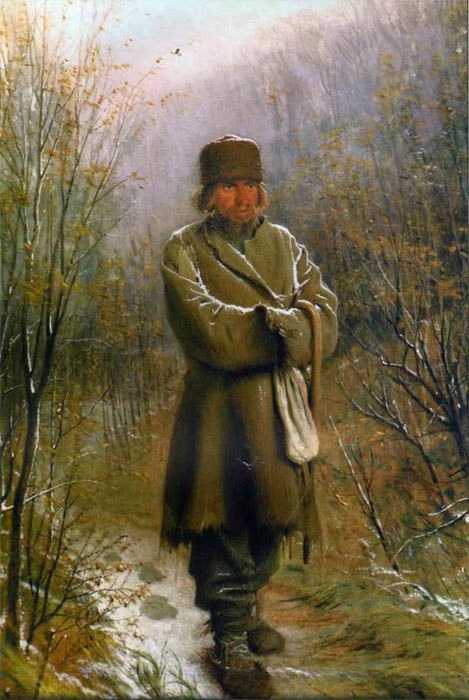Ivan Nikolaevich Kramskoy (1837–1887)
Ivan Kramskoy was born in Ostrogozhsk in the family of an office clerk. Parents hoped that his son would become a clerk, like his father, but the boy from early childhood loved to draw. A neighbor, self-taught artist Mikhail Tulinov taught young Kramskoy to draw in watercolor. Later, the future artist worked as a retoucher - first with a local photographer, and then in St. Petersburg.
Ivan Kramskoy did not dare to enter the capital's Academy of Arts: there was no primary art education. But Mikhail Tulinov, who had also moved to Petersburg by this time, suggested that he study one of the academic disciplines - drawing from plaster. A sketch of Laocoon's head became his opening work. The Council of the Academy of Arts identified Ivan Kramskoy as a student to Professor Alexei Markov. The aspiring artist learned not only to write, but also prepared cardboards for painting the Cathedral of Christ the Savior in Moscow.
In 1863, Ivan Kramskoy already had two medals - Small Silver and Small Gold. A creative contest remained ahead - those who successfully passed it received a Grand Gold Medal and a retirement trip abroad for six years.
For competitive work, the council offered students a plot from Scandinavian mythology - “Feast in Valhalla”. However, at that time, interest in genre works grew in society: paintings depicting everyday life became popular.
Academy students were divided into innovative genre writers and historians who were faithful to old traditions. 14 out of 15 applicants for the Grand Gold Medal refused to write competitive paintings on a mythological plot. First, they submitted several petitions to the council: they wanted to choose their own topics, demanded that the examination papers be considered publicly and give reasoned assessments. Ivan Kramskoy was a “deputy” from a group of fourteen. He read out the requirements before the council and the rector of the Academy and, having been refused, left the exam. The comrades followed suit.
After graduation, young artists had to leave the workshops of the Academy, where they not only worked, but also lived - often together with relatives or friends. There was nothing to rent new apartments and workshops for. To save his comrades from poverty, Kramskoy proposed creating a joint venture - the Artel of Free Artists.
Together, they rented a small building, where everyone had their own workshop and a common, spacious meeting room. The household was run by the wife of the painter - Sofia Kramskaya. Soon, the artists appeared orders: they painted illustrations for books, painted portraits, made copies of paintings. Later, a photo studio appeared in the Artel.
The association of free artists flourished. Ivan Kramskoy was engaged in the affairs of the Artel: he was looking for customers, distributing money. In parallel, he painted portraits, gave drawing lessons at the Society for the Encouragement of Artists. One of his students was Ilya Repin. He wrote about Kramskoy: “That's the way the teacher! His sentences and praises were very weighty and had an irresistible effect on the students. "
In 1865, the painter began to paint the domes of the Cathedral of Christ the Savior in Moscow on cardboard, which he created during his studies at the Academy.
At the end of 1869, Ivan Kramskoy first left Russia to get acquainted with Western art. He visited several European capitals, visited museums and art galleries there. The impressions of Western painters at Kramskoy remained controversial.
When Ivan Kramskoy returned to Russia, he had a conflict with one of his comrades: he accepted a retirement trip from the Academy, which was against the rules of “fourteen”. Kramskoy left the Artel, and soon the association of free artists broke up.
Soon, Ivan Kramskoy became one of the founders of a new creative association - the Association of Traveling Art Exhibitions. Among its founders were also Grigory Myasoedov, Vasily Perov, Alexei Savrasov and other artists.
At the first exhibition of the Wanderers in 1871, Ivan Kramskoy presented his new work - May Night. The painter painted a picture with mermaids bathed in moonlight in Little Russia based on the story of Gogol. The canvas with a mystical plot did not correspond to the program of the Wanderers, however, the work was successful with both artists and critics, and right after the exhibition it was bought by Pavel Tretyakov.
In 1872, Kramskoy completed the painting "Christ in the Desert." “For five years now He has stood before me; I had to write Him in order to get rid of it, ”he wrote to his friend, the artist Fedor Vasilyev. For this painting, the Academy of Arts wanted to award Kramsky the title of professor, but he refused. Pavel Tretyakov bought the picture for a lot of money - 6,000 rubles.
In the 1870s, Kramskoy created many portraits - the artist Ivan Shishkin, Pavel Tretyakov and his wife, writers Leo Tolstoy, Taras Shevchenko and Mikhail Saltykov-Shchedrin, Dr. Sergey Botkin.
Ivan Kramskoy not only wrote canvases, but also published critical articles. He urged to get rid of the influence of the Academy of Arts on art, advocated the creation of drawing schools and workshops where young artists could learn from experienced painters and at the same time maintain their own style. Kramskoy insisted that artists receive a good education: “To criticize the mass, you need to stand above the mass and know and understand society in all its interests and manifestations.”
In the 1880s, one of the sensational works of the artist was "Unknown." The heroine of the canvas - a beautiful lady dressed in the latest fashion - was discussed by critics and the public. The audience was intrigued by her personality, a slightly arrogant look and an outfit that was impeccably fashionable in those years. In the press they wrote about the painting as “Russian Gioconda”, critic Vladimir Stasov called the painting “Cocotte in a Wheelchair”. However, art lovers paid tribute to the skill of Kramskoy, who subtly painted both the face of an unknown lady and her exquisite clothes. After the 11th exhibition of the Wanderers, where the painting was exhibited, it was bought by a prominent industrialist Pavel Kharitonenko.
In 1884, Kramskoy finished the painting “The inconsolable grief”, which depicted a mourning mother at the children's tomb. The artist worked on it for about four years: he made pencil sketches and sketches, changed the composition several times. The picture with the tragic plot Kramskoy presented to Pavel Tretyakov.






























































No comments:
Post a Comment